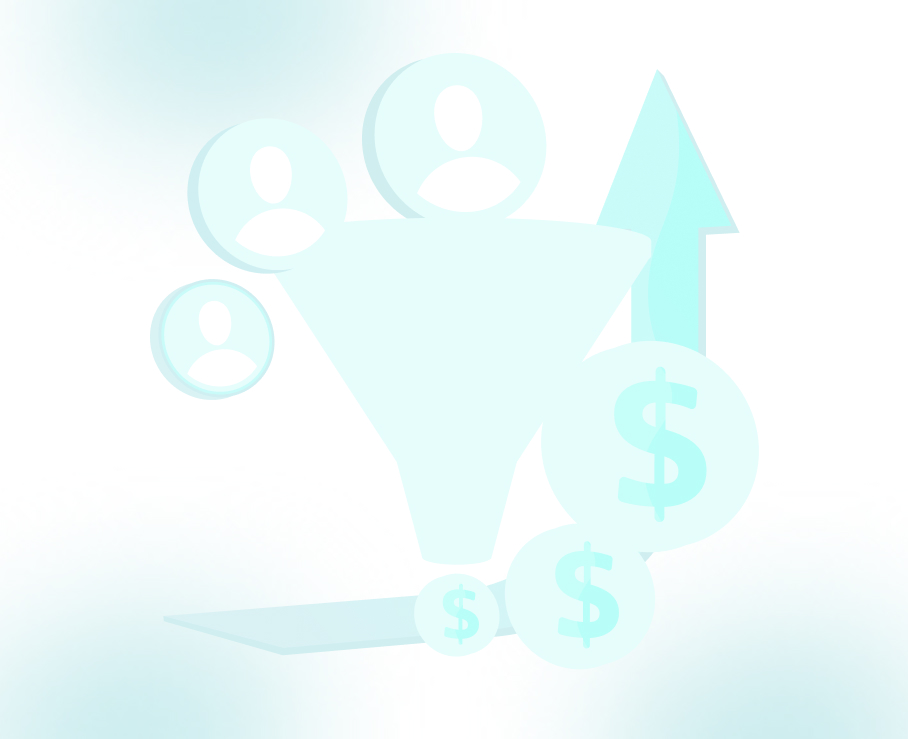
Effective Demand Generation Strategies for SMB Success

Running a small or mid-sized business often means wearing multiple hats. You’re focused on delivering great service or products, yet at the back of your mind, there’s always that nagging question: Where are the next customers coming from? For many, demand generation feels uncertain, time-consuming, and inconsistent.
A recent report shows that 55% of SMBs identify customer acquisition as their biggest marketing challenge. It’s easy to feel overwhelmed when the results don’t match the effort.
The good news is that you don’t need to overhaul everything or break the bank to see progress. Small, strategic changes in how you approach demand generation can lead to measurable improvements. This blog breaks down what’s working for SMBs today so you can move forward with more confidence and less guesswork.
TL;DR:
- Demand generation attracts and nurtures leads, guiding them from awareness to conversion.
- Key strategies like content marketing, email campaigns, and ABM help engage and build trust with prospects.
- Common challenges include unclear targeting, inconsistent messaging, and low engagement with content.
- Email marketing remains a top-performing strategy for consistent, measurable results in lead generation.
What is B2B Demand Generation?
B2B demand generation is a marketing approach focused on attracting business buyers and guiding them through the decision-making process. It involves creating awareness, sparking interest, and offering helpful information that helps potential customers understand your solution.
Instead of pushing for a quick sale, demand generation focuses on building long-term trust. The goal is to create steady interest through content, campaigns, and conversations that address real business challenges. This helps you stay visible and relevant until your prospects are ready to engage.
For small and mid-sized businesses, demand generation is a way to consistently bring in new opportunities while building stronger relationships with potential clients over time.
Demand Generation vs Lead Generation
Demand generation and lead generation are closely connected, but they serve different purposes.
Demand generation is about creating awareness and interest at the top of the funnel, with a focus on reaching the right audience. It’s all about getting your brand in front of potential buyers and helping them understand how your solution can benefit them. This approach often includes targeted email campaigns, educational newsletters, and personalized messaging that gradually build interest and drive engagement over time.
Lead generation comes in later. Once there’s interest, lead generation is about capturing contact details, usually through forms, gated content, or sign-ups, and moving those contacts into your sales funnel.
Think of demand generation as opening the door, while lead generation is inviting someone to step inside. For SMBs, balancing both is key: you need to spark interest first, then make it easy for prospects to take the next step when they’re ready.
To understand how this process actually works in practice, let’s break it down step by step.
Also Read: Definitive Guide to B2B Lead Generation Strategies
How Demand Generation Works
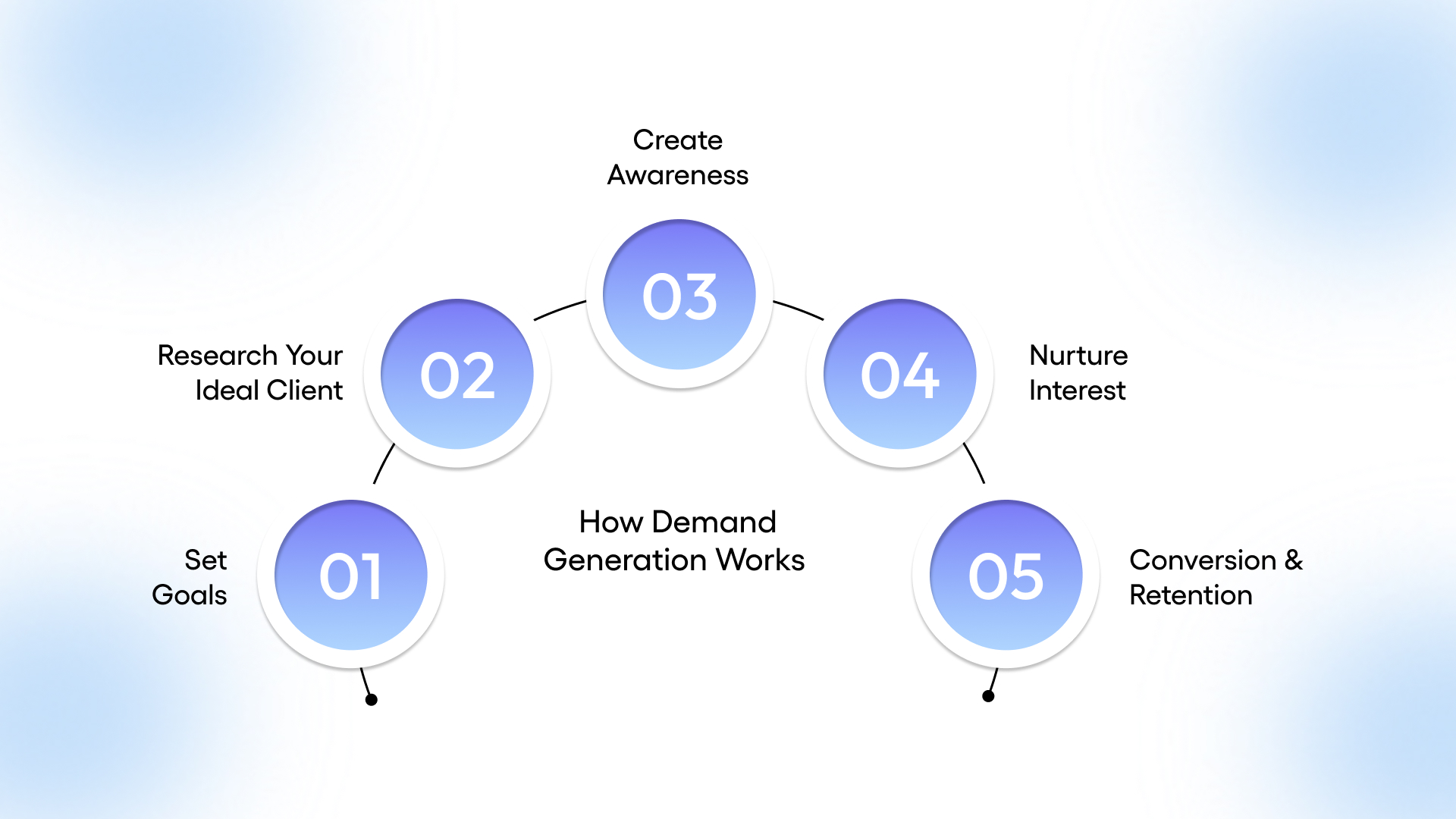
Demand generation is a continuous, structured process that guides prospects from initial awareness to long-term loyalty. By breaking down your approach into clear, actionable steps, you can create a more predictable and efficient pipeline for attracting and converting leads.
Here are the five essential steps:
1. Set Goals
Before diving into demand generation, define clear objectives for your marketing efforts. Whether it’s increasing brand awareness, generating qualified leads, or boosting sales, having specific goals will guide your strategy and ensure you're tracking the right metrics.
2. Research Your Ideal Client
Understanding your target audience is crucial. Identify your ideal customer profile, including their pain points, needs, behaviors, and preferences. This helps you create messaging and content that resonates with them, ensuring you're reaching the right people.
3. Create Awareness
The next step is making potential customers aware of your brand. Utilize a combination of content marketing, targeted email campaigns, and webinars to showcase your solution’s value. The goal is to ensure your product or service reaches the right audience and demonstrates how it addresses their specific challenges.
4. Nurture Interest
Once people know who you are, focus on building their interest. Engage them with educational content, case studies, and personalized outreach to show how your solution can specifically address their challenges. It’s important to create value and build trust, not just push for a sale.
5. Conversion & Retention
Finally, your efforts culminate in converting engaged prospects into customers. Make the buying process simple and clear, and continue nurturing your relationships with post-sale support and follow-up. Happy customers can become your best advocates, driving more demand through word-of-mouth.
By following these steps, you can guide prospects through a well-defined journey that ultimately leads to long-term success for your business. The next step is choosing the right strategies that keep that journey moving—ones that not only capture attention but also build lasting interest.
Top 7 Demand Generation Strategies
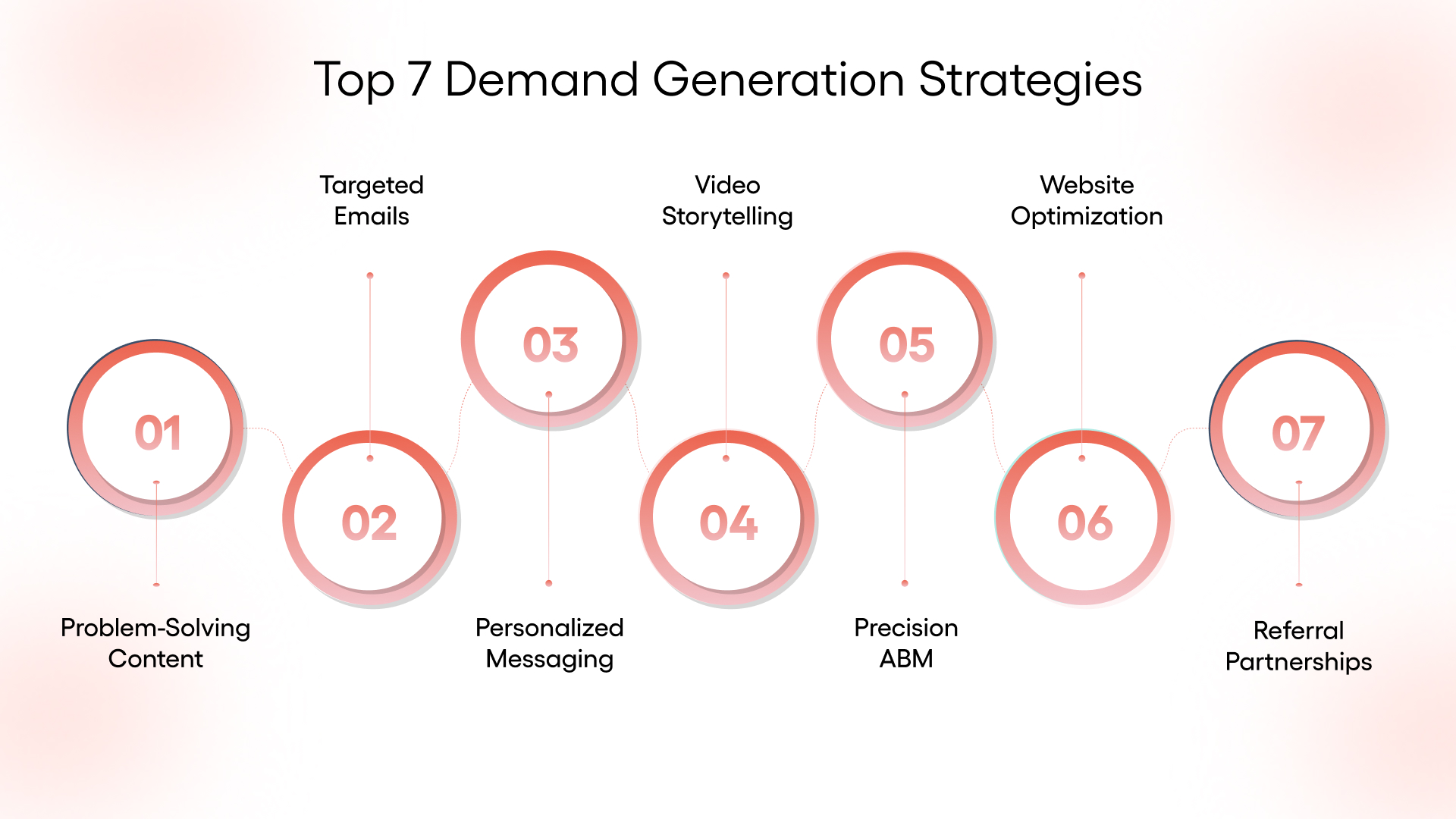
To successfully drive growth, small and mid-sized businesses need to implement strategic and effective demand generation tactics. By focusing on these methods, you can create a sustainable pipeline of qualified prospects and maximize the impact of your marketing efforts.
Here are the top 7 strategies you can use:
1. Create Content That Solves Real Problems
People don’t want more content; they want answers. When you consistently create material that tackles the real problems your target audience faces, you position your brand as a trusted resource, not just another name in their inbox.
Why It Works:
- Builds credibility and long-term trust
- Attracts inbound interest from people actively seeking solutions
How to Do It:
- Talk to your customers. What slows them down? What frustrates them?
Use that feedback to develop guides, explainers, or “how-to” content across formats, blogs, quick PDFs, explainer videos, or short LinkedIn posts.
Don’t overthink production, think clarity. If your content helps someone do their job better, it’s working.
Also Read: Effective Email Marketing for Demand Generation
2. Run Smart, Targeted Email Campaigns
Email remains one of the most effective ways to reach people, with 51% of consumers saying it’s their preferred method of communication from brands. By tailoring your emails to specific groups based on their interests or stage in the buying journey, you create a direct, consistent way to stay relevant and build trust over time.
Why It Works:
- Reaches people directly in their preferred space
- Easy to test, optimize, and scale when done right
How to Do It:
- Segment your contacts by industry, pain points, or stage in the decision journey
- Build sequences that educate, not hard-sell, and help them understand the problem and why your solution is worth a second look
How TLM Helped an M&A Advisory Gain Consistent Leads
Take our work with a California-based M&A advisory firm that specializes in brokering deals between buyers and sellers in the managed service provider (MSP) space. The client had been relying heavily on references and cold calls, but struggled to find MSPs interested in selling, especially in specific geographies where demand outpaced supply.
TLM stepped in with a focused B2B email campaign, targeting mid-sized MSPs with 20–150 employees. We built a three-touchpoint outreach strategy and synced qualified responses directly to the client’s calendar.
The results spoke for themselves: within the first month, we secured an initial lead. By month two, the campaign was consistently producing 2–3 strong leads per month, with a total of 13 inquiries generated in a short span. The client was thrilled, saying the outcomes far exceeded expectations.
The takeaway? A smart, targeted email strategy, paired with the right list and messaging, can unlock demand even in narrow, high-stakes markets.
3. Hyper-Personalization: Speak To People, Not At Them
Generic messages feel like noise. Personalization tells the buyer you’ve done your homework. Hyper-personalization goes beyond using someone’s name; it tailors your messaging based on behavior, interests, or past interactions. And yes, it’s worth the effort.
Why It Works:
- Makes your message relevant and timely
- Increases engagement and response rates
How to Do It:
- Track what content a lead engaged with, what they downloaded, clicked, or replied to
- Reflect those insights in your next message: “I noticed you checked out our guide on reducing downtime, thought this might help too…”
People are more likely to engage when your message feels like it was written just for them, because it was.
4. Use Video to Show, Not Just Tell
Text explains. Video connects. Whether you’re introducing your service, demonstrating how it works, or sharing customer stories, video builds confidence. For busy decision-makers, a 90-second video can say more than 900 words.
Why It Works:
- Builds trust through tone, body language, and visual proof
- Makes it easier to explain complex ideas or services
How to Do It:
- Start simple: Record short walkthroughs or FAQs using tools like Loom or Zoom
- Creating customer testimonial videos, even basic ones shot over Zoom, can make a real impact
You don’t need flashy production. You need clarity, honesty, and relevance.
5. Account-Based Marketing (ABM) with Precision
Not all leads are created equal. ABM lets you focus your energy on the accounts that matter most, those that align with your ideal client profile.
Why It Works:
- Aligns sales and marketing around the same high-priority accounts
- Increases deal size and conversion by delivering tailored value
How to Do It:
- Identify 10–30 high-value accounts using filters like industry, revenue, and decision-making structure
- Build outreach campaigns that are custom to their challenges, using content, video, and 1:1 messaging
Want to know what ABM could look like for your business?
At TLM, we help businesses zero in on their dream clients and speak to them in a way that gets responses. Start here.
6. Make Your Website Work For You
Your website is more than a brochure; it’s where decisions start. If someone lands on your page and doesn’t know what to do next, you’re leaving leads on the table.
Why It Works:
- Converts curiosity into action
- Encourages visitors to take the next step, even after hours
How to Do It:
- Add compelling calls to action (CTAs) across key pages, think “Schedule a call” or “Download comparison checklist”.
- Offer practical lead magnets: Templates, short guides, or access to whitepapers.
No need for flashy design, just make it easy for a visitor to say yes.
7. Build Strategic Referral Partnerships
When you're in a specialized market, warm introductions often outperform cold outreach. Strategic referral partnerships, where two non-competing businesses share similar client profiles, can open doors to high-quality leads without spending on broad marketing tactics.
Why It Works:
- Leads come in pre-qualified and pre-warmed through a trusted third party
- Increases credibility and shortens sales cycles
How to Do It:
Identify service providers or consultants who work with your target audience but don’t compete with you (e.g., for an M&A advisory firm, this might be financial advisors, MSP consultants, or niche legal firms)
- Offer mutual value: share resources, co-host virtual events, or set up a structured referral program
- Keep it relationship-focused—this works best when the trust is genuine
These partnerships don’t require massive investment, just intentional outreach and alignment. And the leads? Often far more valuable than anything you’ll get from a cold campaign.
By leveraging these strategies, your SMB can create a well-rounded demand generation approach that consistently brings in new leads and nurtures them toward becoming loyal customers. This kind of steady, intentional effort doesn’t just fill your sales pipeline; it also has a direct impact on your bottom line.
How Demand Generation Drives Revenue
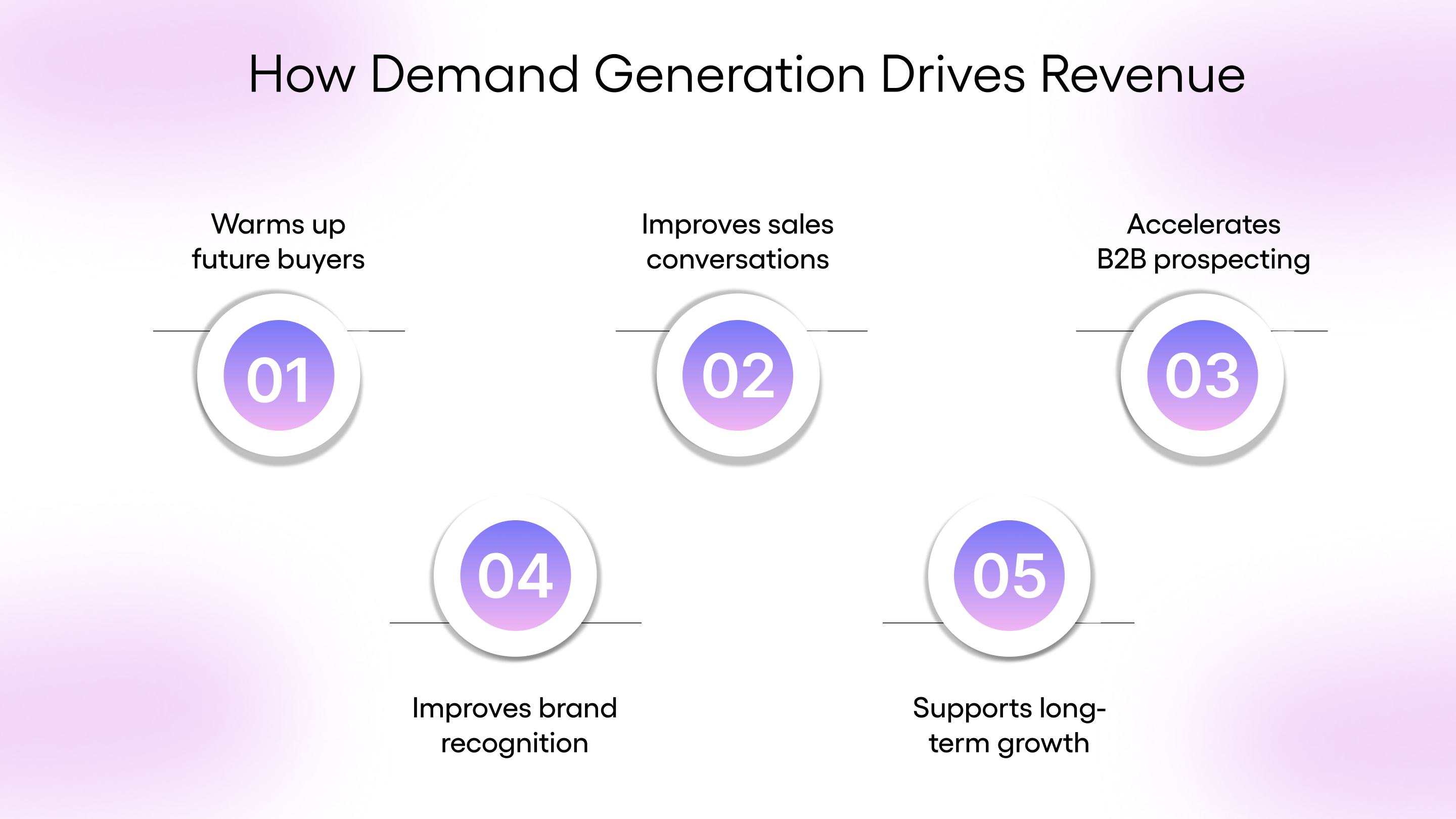
Demand generation helps you attract the right people, earn their trust, and stay relevant throughout their decision-making journey. It creates a steady flow of interest that fuels growth without relying on one-off campaigns.
Here’s how it directly contributes to revenue in simple, measurable ways:
- Warms up future buyers: You’re not starting from zero. When people already know your brand, sales cycles become shorter and more natural.
- Improves sales conversations: Leads coming from demand gen efforts are more informed, which makes conversations more productive and focused.
- Accelerates B2B prospecting: With demand already in place, your outreach becomes more targeted and better received, opening doors faster.
- Improves brand recognition: The more valuable touchpoints you create, the more your brand stays visible and trusted across your market.
- Supports long-term growth: Demand generation keeps interest flowing, helping you build a reliable revenue engine over time.
This approach helps build a business that grows steadily and attracts customers for the right reasons. However, even with a solid strategy, demand generation can present its own set of challenges that are worth understanding upfront.
Common Challenges in B2B Demand Generation
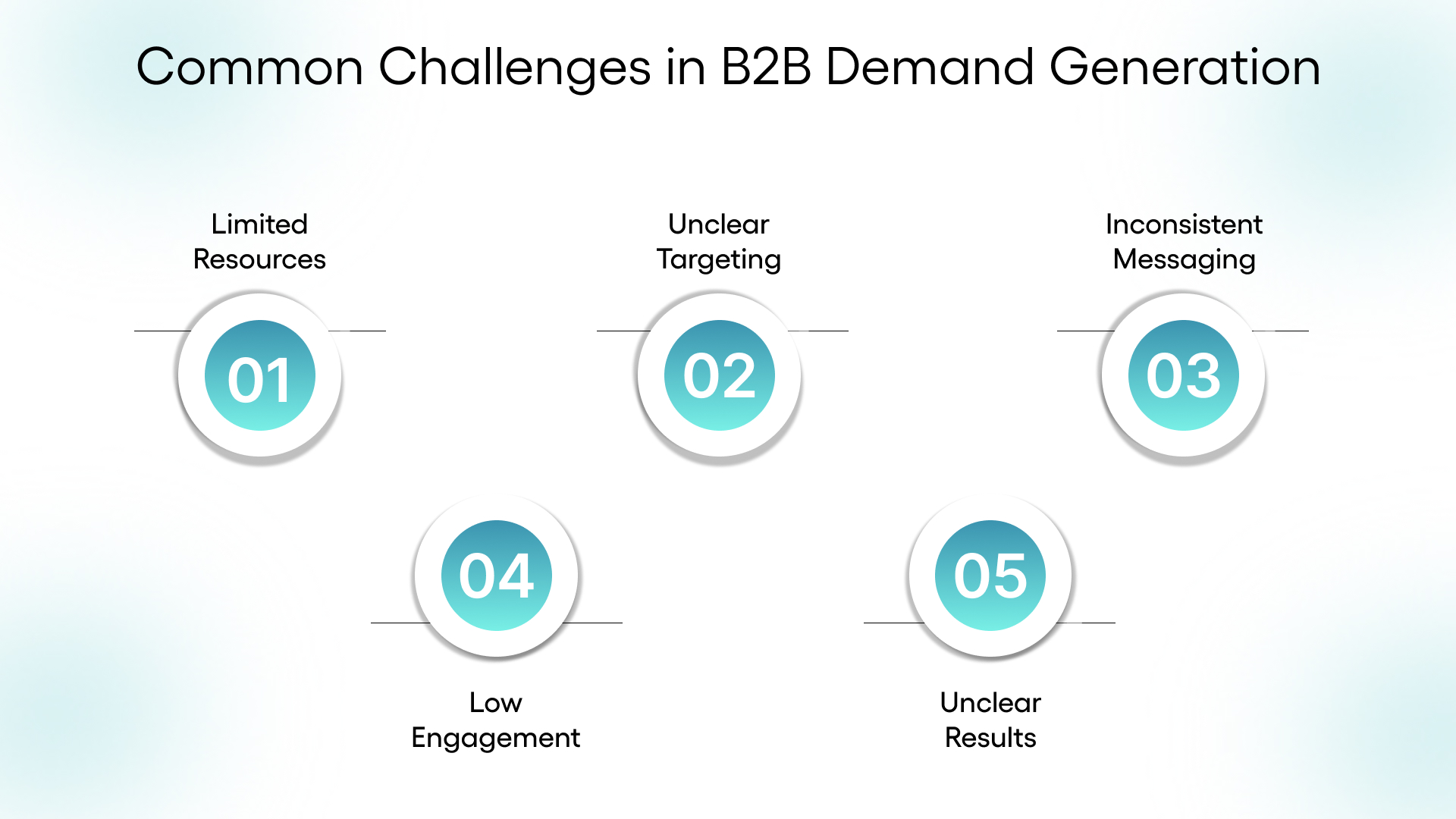
If you’ve ever felt like you’re doing all the right things but still not seeing results, you’re not alone. Demand generation can be tricky, especially when you’re running a small team and wearing multiple hats.
Here are some of the most common roadblocks you might be facing:
- You Don’t Have a Huge Budget or Team
Let’s face it. Most SMBs don’t have a dedicated demand gen department. You’re probably stretching limited time and resources, trying to keep things moving while also closing deals and running the business.
- You’re Not Exactly Sure Who You’re Targeting
If your messaging feels scattered, or you’re unsure who your ideal buyer is, you’re not alone. Without a clear picture of your audience, even well-crafted efforts can fall flat.
- Your Message Keeps Shifting
When your content, emails, and outreach all sound a little different, it creates confusion. A lack of consistent messaging makes it harder for prospects to trust what you’re offering.
- You’re Creating Content, But No One’s Engaging
Maybe you’ve written blogs or made videos, but the response has been quiet. It’s frustrating, especially when you know the content is good. Often, it’s a distribution or relevance issue, not a quality one.
- It’s Hard to Tell What’s Working
You put time into campaigns, but it’s unclear if they’re driving revenue. When results are fuzzy, it’s tough to double down or even know where to begin next.
Also Read: Overcoming B2B Lead Generation Challenges and Solutions
These challenges are real, and they can feel overwhelming. But they’re also fixable. With the right structure and focus, demand generation becomes less of a guessing game and more of a steady, repeatable system.
How TLM Supports Demand Generation for SMB Success
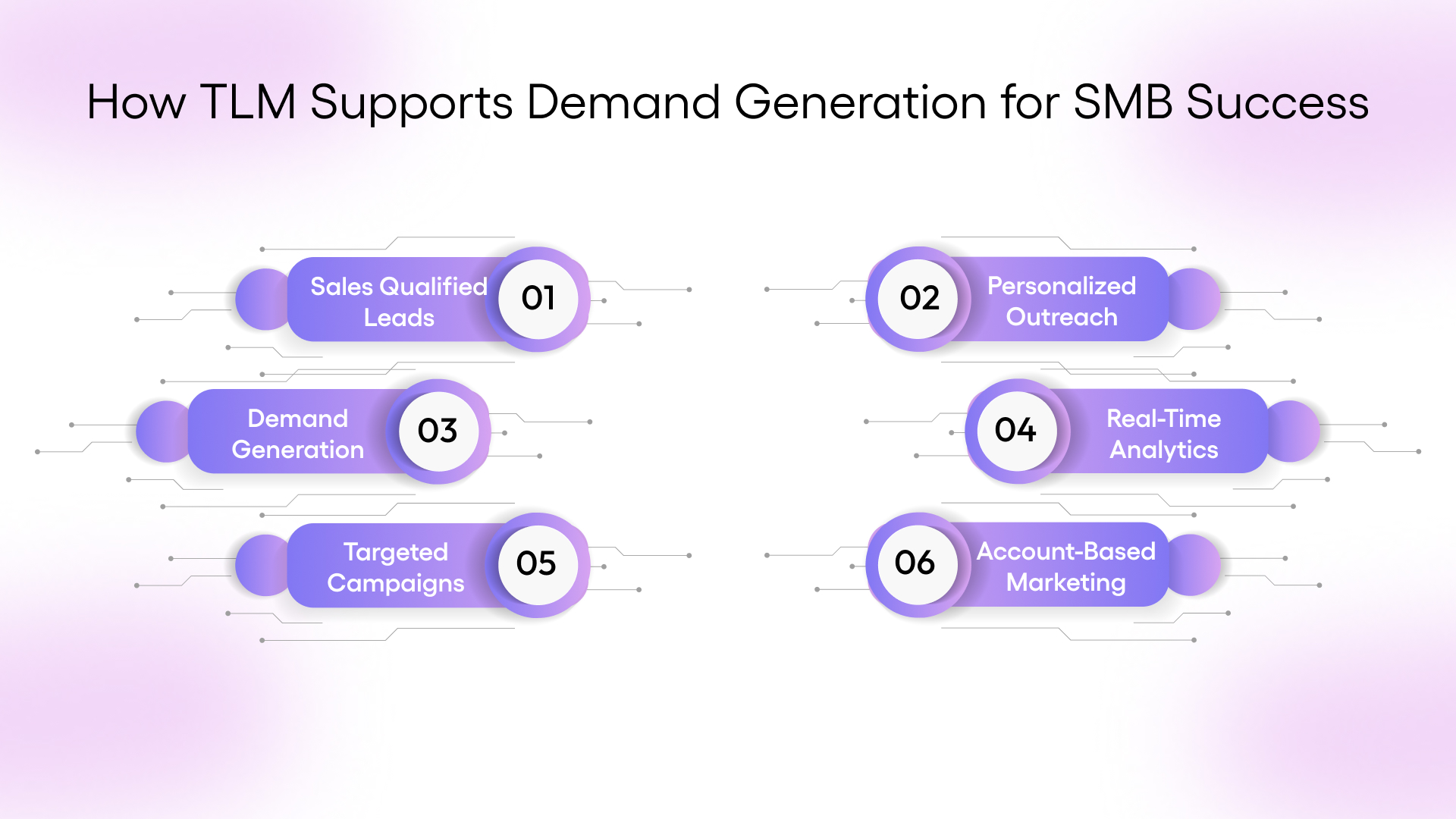
TLM’s approach to demand generation is designed to help small and mid-sized businesses generate high-quality leads and convert them into long-term customers through a structured, effective process.
Here’s how we help SMBs succeed in demand generation:
- Sales Qualified Leads (SQL): We focus on generating leads that are ready for sales engagement, ensuring that your team spends time on prospects most likely to convert.
- Personalized Outreach: Each message is tailored to the specific needs of your audience, increasing relevance and engagement with prospects.
- Demand Generation: We nurture leads with consistent, valuable communication to keep prospects engaged and prepared to take the next step when they’re ready.
- Real-Time Analytics: Our real-time insights enable you to track campaign performance and inform your decision-making process, helping you identify the right prospects.
- Targeted Campaigns: We run focused campaigns that speak directly to specific audience segments, leading to better engagement and higher-quality leads.
- Account-Based Marketing (ABM): We personalize outreach for key decision-makers within high-value accounts, building stronger relationships and increasing conversion potential.
These features are designed to make your demand generation process more efficient and ensure that your outreach is aligned with your growth objectives. By streamlining these efforts, we help you build better long-term customer relationships and achieve higher conversion rates.
TLM has helped businesses turn fragmented strategies into cohesive systems that deliver measurable results.
If you’re ready to refine your demand generation approach and drive sustainable growth, let’s schedule a meeting and build a plan that works for you.
FAQs
1. What is a demand generation strategy?
A demand generation strategy focuses on creating awareness and interest in your product or service through targeted marketing efforts aimed at attracting potential customers.
2. How to do B2B demand generation?
B2B demand generation involves identifying and targeting business decision-makers through content, email marketing, and targeted outreach to build interest and nurture relationships.
3. What is the demand generation model of a business?
The demand generation model refers to how a business attracts, nurtures, and converts prospects into customers using strategic marketing tactics and campaigns.
4. What are the eight stages of demand?
The eight stages of demand include awareness, interest, consideration, intent, evaluation, purchase, post-purchase, and loyalty.





